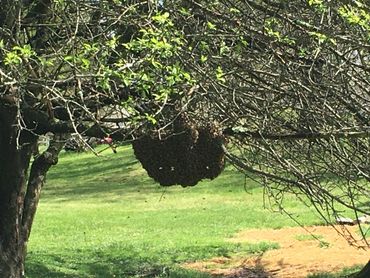(540) 317-1170 (text preferred)

Honeybee Swarms
What is a swarm and why do honeybees do it?
Swarms are a honeybee colonies' natural way of reproducing. When the colony gets too crowded in the parent (original) hive, the workers prepare for a new queen to be raised; the original queen and about half of the workers leave the colony in a cloud. They'll all settle down for a short time in a cluster nearby. They could settle on a bush, tree, BBQ grill, car, bench, or any other item close-by. While they're clustered, scout bees go out to search for a new home. Once a few options have been located, the scout bees 'present' their selection to the group; after selecting the preferred option, the group flies off to their new home. Swarming most often occurs from early-mid April (sometimes late March) through mid-late June (sometimes even later).
There is no need to worry or panic if you see a swarm. The best thing to do is contact a beekeeper to come collect it (see list below) - please DO NOT CALL an exterminator. You can also leave it alone; within 1-2 days it will likely move off on its own. Occasionally, the new home the bees choose is in the side of a dwelling, accessible through a hole in the siding of a house, or around the flashing on a chimney. If a honeybee colony takes up residence in a home, it can cause significant damage to the dwelling. Colony removal from dwellings are done by a select group of beekeepers. A lot of work is involved in this type of 'cut-out'. It's usually not done for free, and the homeowner will need to arrange for the immediate repair of the area. Oftentimes, the beekeeper is not the same person that does the repair. It's important to repair the dwelling immediately because that area now has an attractive odor that other scout bees will be drawn to. We've seen instances where a new swarm of bees has moved in to a recently cut-out area of a dwelling, because the repair was not done in a timely fashion.
Bee Removal/Cut-outs (Removing bees from structures)
Removing bees from structures can be a complicated and involved process and usually involves some carpentry. Expect this service to have a fee. If you have honeybees in your wall, you can contact these beekeepers to discuss removal options:
Patti Wills: 703-297-2429*
Haymarket Hives: 703-304-5494* (ask for Jeff)
Darrell Thompson: 810-513-5354* (Stafford/Fauquier border; will travel 30-45 min)
Swarm Collection (bees seen clumped together in an exposed area)
If you have a swarm, please consider contacting us for assistance:
Fern Hill Apiary - Donielle & Mike Rininger: 540-317-1170 (Central & Northern Fauquier County and nearby) - please complete this swarm collection request form
Shelly Shell: 571-445-0991- (swarms only - avail in Culpeper County)*
More information is available, including contacts for others who help with swarm removal and/or cut-outs through these websites:
Beekeepers of Northern Shenandoah / Prince William Regional Beekeepers Association
*inclusion in this list does not imply endorsement by or of Fern Hill Apiary
Have a swarm? Call/Text us!
Swarms are not aggressive and very beneficial. Please DO NOT spray a honeybee swarm with insect killer or call an exterminator - instead, contact a beekeeper, like us!
Call/text us at 540-317-1170 or complete this form (form preferred as it provides us with all the needed details). Let us know where you're located, how accessible the swarm is, how long it's been there, and your contact info so we can get in touch.
Video: Why There's no Need to Panic Over a Swarm of Bees
What does a swarm look like?












Cookie Policy
This website uses cookies. By continuing to use this site, you accept our use of cookies.
